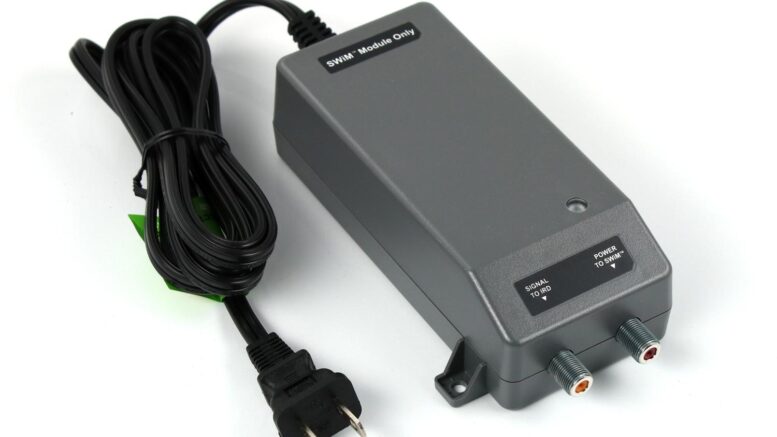I recently explained the basics of a DIRECTV power inserter to one of the team at Solid Signal HQ. A power inserter, I said, is a pretty simple thing. It takes power and puts it on the same coax line as the signal from the dish. Before it does that, it transforms the 110 volt AC power to 29 volt DC power, but that’s no trick. Pretty much every cell phone charger does a similar thing, just with less voltage.
The whole thing with putting the current on the coax cable is a neat trick. It relies on a basic theory of RF transmission called “the skin effect” which allows signals to travel on the outer edge of a cable while power travels through the center. It’s also notable that the signals are coming down from the dish, while the power is going up.
About that flashing light?
The power inserter has a green indicator light. It will do two things. First of all, if the light is on at all then you’re getting power to the power inserter. If it’s solid, then the dish or multiswitch is responding to the power inserter. If the light is flashing, there’s no response from the power inserter. This could be due to one of three things:
- The dish or multiswitch is still starting up. (Wait 3 minutes.)
- There is a break in the line, due to a cable or connector problem.
- There is something quite, quite wrong with the dish or multiswitch.
When you see that flashing light, 90% or more of the time it’s going to be the first thing. It takes a minute or so for everything to sync up. Be patient and wait it out. If it’s still flashing after 3-4 minutes, check to see that everything is connected and the cable is in good shape. If possible try substituting another cable.
If neither of those things solve the problem, then there’s something going on with the dish or multiswitch. This is EXTREMELY rare to be honest. Even if there is a problem with the dish or multiswitch, the light will generally turn solid. It’s a very simple detector. It can’t tell whether you are receiving signal or if everything is working as it should. If the light is solid, the power inserter sees the thing it’s powering. If it’s flashing, it doesn’t.
While we’re talking about power inserters…
Here are a few more things to consider.
If your power inserter is black instead of grey, replace it.
The black power inserter supplies only 21 volts which is the minimum you really need to power a dish under perfect circumstances. It’s not used in new installations anymore. All new installs get the grey inserter, which supplies 29 volts and gives the whole system a little breathing room.
Ignore the connector called SIGNAL TO IRD.
It’s possible to simplify your installation by connecting a receiver straight to the SIGNAL TO IRD port. However, it doesn’t give you any more signal and it is risky. If you accidentally connect to the POWER TO SWM port, you’ll fry the receiver. Here’s a better way to connect everything up.
Leave the power inserter alone and you’ll just be happier.
As I said at the top of this article, the power inserter is a pretty simple device. It’s also a pretty reliable one. I’ve had the same grey power inserter in my home DIRECTV system for 15 years and the only times it’s stopped working were when the power was out. If you’re looking to find a problem in your DIRECTV system, start by looking elsewhere. Chances are you’ll find that the problem isn’t with the power inserter at all.
Shop for DIRECTV accessories at Solid Signal
Solid Signal is your home for DIRECTV accessories, the same ones used by technicians in the field. Shop the great selection now! If you need help choosing the right parts, give us a call! We’re here for you during East Coast business hours at 888-233-7563. If it’s after hours, just fill out the form below and we’ll get right back to you.



